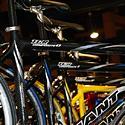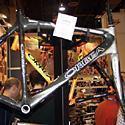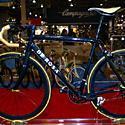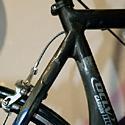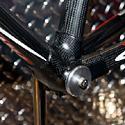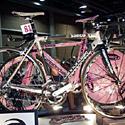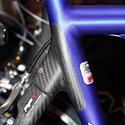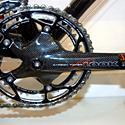
|
Eurobike EICMA Bicycling Australia Show Cycle 2003 Interbike Japan |
| Eurobike
pics EICMA pics Bicycling Australia pics Cycle 2003 Interbike Japan |
Recently on Cyclingnews.com |
Interbike 2003
Las Vegas, USA, October 10-14, 2003
Interbike round-up #1: High-end road bikes - the year of carbon
Now the show season is over it's time to take a broader look at what the bike industry has in store for us in 2004. In the first of a series of show round-ups, John Stevenson and Gerard Knapp examine the year's strongest trend in high end road bikes: the carbon takeover.
|
One word dominates the high-end bike landscape in 2004: carbon.
It's been a while coming. Carbon fiber bikes were once the exclusive province of the very wealthy and the insanely talented. You got a carbon bike by shelling out a metric buttload of money or by getting on the Olympic program of a country with a cashed-up governing body. Not any more. While carbon frames aren't yet quite a commodity, the development over the last few years of sensibly-priced, Taiwanese-made frames from companies such as Giant and Cervelo means they're within the reach of most of us.
These lower-priced carbon frames also have at least one very well-known US maker of carbon frames wondering if it is going to have to move production overseas to compete. Look, arguably one of the pioneers of mass-produced carbon fiber bikes, has already moved production to Tunisia, and it seems likely this won't be the last such measure.
There are two main ways of building a frame from carbon fiber. You can either mould the whole frame in one piece in the technique known as 'monocoque' construction, or you can bond carbon tubes into carbon lugs. Monocoque adherents claim it's more weight-efficient, because there's no extra material at the joints (because there are no joints) while tube-and-lug guys point out that their way of doing things trades off a few grams for a substantial cost savings.
Giant has been leading the charge in affordable carbon for several years, and the news that the T-Mobile Team Formerly Known As Telekom will be aboard Giant carbon bikes in 2004, complete with the prodigal Jan Ullrich will do the credibility of Taiwan's biggest builder no harm.
Other manufacturers known for their previous devotion to aluminium and sponsorship of top pro teams are also leaping into carbon, to the point where you have to wonder if there'll be a top pro team in 2004 that's not on carbon bikes.
Specialized, current bike sponsor of Mario Cipollini's Domina Vacanze team, has been trumpeting its Roubaix frame for a little while now. With its claimed frame weight of 990g and shock-damping Zertz elastomer inserts in the monocoque frame, Specialized claims the Roubaix damps up to 80 percent of vibration that would otherwise get to the rider. That's a big claim - it'll be interesting to see how the bike goes on through roads of next year's Belgian Classics.
Orbea, long-time supplier of bright orange bikes to the Euskaltel-Euskadi team, has leapt two-footed into carbon with the Orca, an all-carbon frame with a claimed weight of 1000g for a 54cm.
Joseba Arizaga, Orbea's direct marketing manager, said the Orca is a combination of a monocoque main triangle bonded to CF rear stays (the same as those used on the existing Starship models). It's expected that riders on the Euskaltel-Euskadi team will be given the opportunity to throw a leg over the new carbon rigs during the off-season to familiarise themselves with the new bike's properties and dimensions. In the US, the enhanced Jelly Belly team will also ride Orcas in 2004. "This year's race bike is next year's training bike," as Orbea USA's Tony Karklins put it.
The Euskaltel team receives full support of the Orbea factory, which means accommodating the riders' whims and preferences. "Nearly all of the [EE] riders have custom geometry," Arizaga said. "But they're only small differences and with the lighter weight and ride quality [of the Orca], they may not notice those small differences so much," he added with a grin. Of course, accomodating the minutiae of rider preferences is something that's hard to do with carbon, although De Rosa offers a certain amount of customisation of its frames.
As a sidebar, one of EE's most fastidious riders is Haimar Zubeldia, who rode particularly well at this year's Tour de France. He continually requested a time trial frame with a relaxed seat angle - believed to be 72.5 degrees - something the frame builders were reluctant to agree to, given that most TT frames have sharper seat angles of 74 or higher. However, they relented and Haimar got his bike. In its first outing, he bagged a TdF podium spot when he surprised the cycling world by coming third in the prologue behind Brad McGee and David Millar.
This anecdote highlights one of the limitations of carbon - customisation. A custom monocoque frame is out of the question, while bonded frames have limitations compared to welded metal frames. Nonetheless, specialist firms such as Parlee Cycles in the US offer custom-made, bonded carbon frames, in addition to regular models.
More carbon from the specialists
|
The carbon takeover isn't just affecting companies new to composite construction such as Orbea. Established carbon manufacturers like Giant, Trek, Fondriest, Colnago, De Rosa, and Time all have expanded ranges of carbon bikes for 2004. Giant has gone from three models to four in 2004, for example, and substantially dropped the price of all its carbon-framed bikes. De Rosa has added the Cinquanta to its range, an all-carbon frame and fork that tops out above the existing King; and the King is now available in a non-sloping variant in one-centimetre size increments for fit purists.
Colnago, of course, announced its fiftieth anniversary C50 HP superbike earlier this year, almost as if to squash the idea that carbon bikes are becoming affordable. At an RRP of $6,699 for a complete Dura-Ace-equipped bike, the C50 is definitely at the exclusive end of the carbon range...
Trek's Madrone 5.9 is perhaps the most bally-hooed new bike of the year, and needs little more to be said about it here. At Interbike, Trek displayed an unpainted version so composite fans could get up close and personal with the bare fibers.
Time is another carbon maker that has gone hard at the top end of its range. The new VXRS model incorporates carbon everything into what Time calls a 'module': frame, fork, headset, handlebar stem and even a bottle cage, all in carbon. The total weight is claimed to be 1750g for a 55cm, which compares favourably with adding up even the lightest of those components separately.
One dramatic place Time has saved weight is in the seat post: the VXRS doesn't have one, at least not in the conventional sense. Instead, the seat tube extends through the seat lug and a clamp holds the usual seatpost hardware necessary to mount a saddle. Time claims a weight saving of 40g and an increase in rigidity.
Biciclette Fondriest, the company of former pro Maurizio Fondriest that a couple of years ago boasted just one carbon frame, now offers six models, from the monocoque Top Carbon TF1 at US$4,899 down to the bonded Carbon DFC using Dedacciai's new carbon tube set for US$1,999. There's even the Golden Renaix, a junior version of the Carbon LEX, sized to take 24in wheels.
Wilier Triestina, the Italian builder noted for the bike on which Marco Pantani set a record for the ascent of Alpe d'Huez in 1997, has three carbon offerings for 2004. The Imperiale is new at the top of the range, a monocoque construction frame with a claimed weight if 1,180g, the dramatically-style Karbon 2 at 1,200g and the Izoard - now all-carbon - comes in at 1,350g.
Carbon combinations
As well as a plethora of all-carbon bikes, manufacturers are finding more and more ways to combine carbon with metals to tune the ride. Bridging aluminium lugs with carbon tubes is the oldest and simplest incarnation of this idea, and bike makers have been quietening the ride of super-stiff aluminium frames by building in carbon fiber seatstays for a few years now.
In 2004 you will be able to pick up just about every carbon-plus-something variant you can imagine. Here's a quick list of the ones we spotted at the show:
|
LeMond Tête de Course and Victoire: Carbon top tube, seat tube and seatstays with titanium 'spine' (downtube, chainstays, and head tube.
Cannondale had the carbon/aluminium frame that Gilberto Simoni and Saeco rode in this year's Giro on display at Interbike, but still isn't saying when, or even if, the frame will be available.
Specialized Tarmac: carbon top tube, seat stays and top half of seat tube; aluminium down tube, chainstays, head tube and lower seat tube.
Fondriest Carb Level Plus SAT: carbon seatstays and chainstays; alumiunium front triangle.
Argon18 Krypton RPT and Mercury Aero RPT: carbon seatstays and chainstays with aluminium front triangles and some of the tidiest wrap-around melding of the two materials we've seen.
Orbea Ultrafoco Carbon: Carbon seatstays in a Colombus Ultrafoco steel frame. Like almost every other manufacturer Orbea also has aluminium frames with carbon seatstays, but this unusual combo caught our eye.
Van Tuyl: Carbon top tube, down tube, seat stays and chainstays with titanium head tube and seat tube.
Wilier Triestina Galibier: Welded titanium seat cluster, bottom bracket cluster and head tube area, joined with carbon tubes.
Carbon, carbon everywhere
The carbon takeover isn't just happening to frames. As we'll see in a later round-up when we look at the pick of 2004's components and accessories, composites are being used for eveything from bottle cages to rims and cranks to handlebars.
Photography
For a gallery of thumbnails of these pictures click here
Images by Jon Devich/www.epicimages.us
- De Rosa's Cinquanta celebrates the builder's fiftieth anniversary with an all-carbon superbike to top out the range.
- De Rosa's Cinquanta sports a curvaceous one-piece carbon bar and stem
- De Rosa's Cinquanta even has a carbon rear hub!
- De Rosa's Cinquanta - the only word for this bottom bracket area is 'beefy'
- Giant's carbon offerings number four bikes for 2004
- Giant's all-carbon front end - fork, stem and bar are all composite on the Tour Centenary bike
- Giant's Tour Centenary bike up close and personal
- Giant's time trial bike uses slippery aero shaping in its carbon frame and seat post
- Time's frames use the company's own 'Ultrasafe' fork
- Time's carbon stem is part of the company's package of frame, fork, stem and seatpost
- Time's carbon BB takes bonded-in tubes and stays
- Trek's Madone 5.9 sits above trek's previous top end 5900 Ultralight in the Wi8sconsin maker's carbon range
- Trek's Madone 5.9 naked so you can see the joins
Images by Robert Gilbreath/Cyclingnews
- Argon18 joins carbon to aluminium by bonding the composite to the metal in this partially-wrapped configuration.
- Argon18's Mercury time trial bike shows off the Canadian company's unique approach to combining carbon and aluminium
- Argon18's all-carbon Platinum showcases careful lay-up to tune the ride.
- Cannondale's carbon/aluminium bike as used by Gilberto Simoni. No release date has yet been set.
- Orbea's Orca is the new all-carbon frame from the Spanish Euskaltel supplier. Will we see Mayo on one in 2004?
- Parlee's seat cluster - the aluminium collar looks almost incongruous
- The Seven Elium combines carbon and titanium
- Seven's Elium in close up - carbon tubes mate into welded titanium lugs
- The Specialized Tarmac mates an aluminium lower frame with a carbon upper half for stiffness and shock damping.
- Van Tuyl is one of a handful of companies combining carbon and titanium
- Van Tuyl's titanium/carbon combo - as much welding as a titanium bike, plus the added cost of carbon!
Images by Gianmarco Cilli/Velo Imports
- Wilier Triestina's Karbon 2 is back for 2004 in a clear coat to show off its monocoque construction
- Wilier's Izoard - all-carbon for 2004
- Wilier Karbon 2 up close and personal
Images by Chris Henry/Cyclingnews.com
- Look's latest KG486 is the likely ride of the full Kelme and Credit Agricole teams in 2004
- Look's carbon cranks are one of a vast number of carbon components and accessories for 2004


